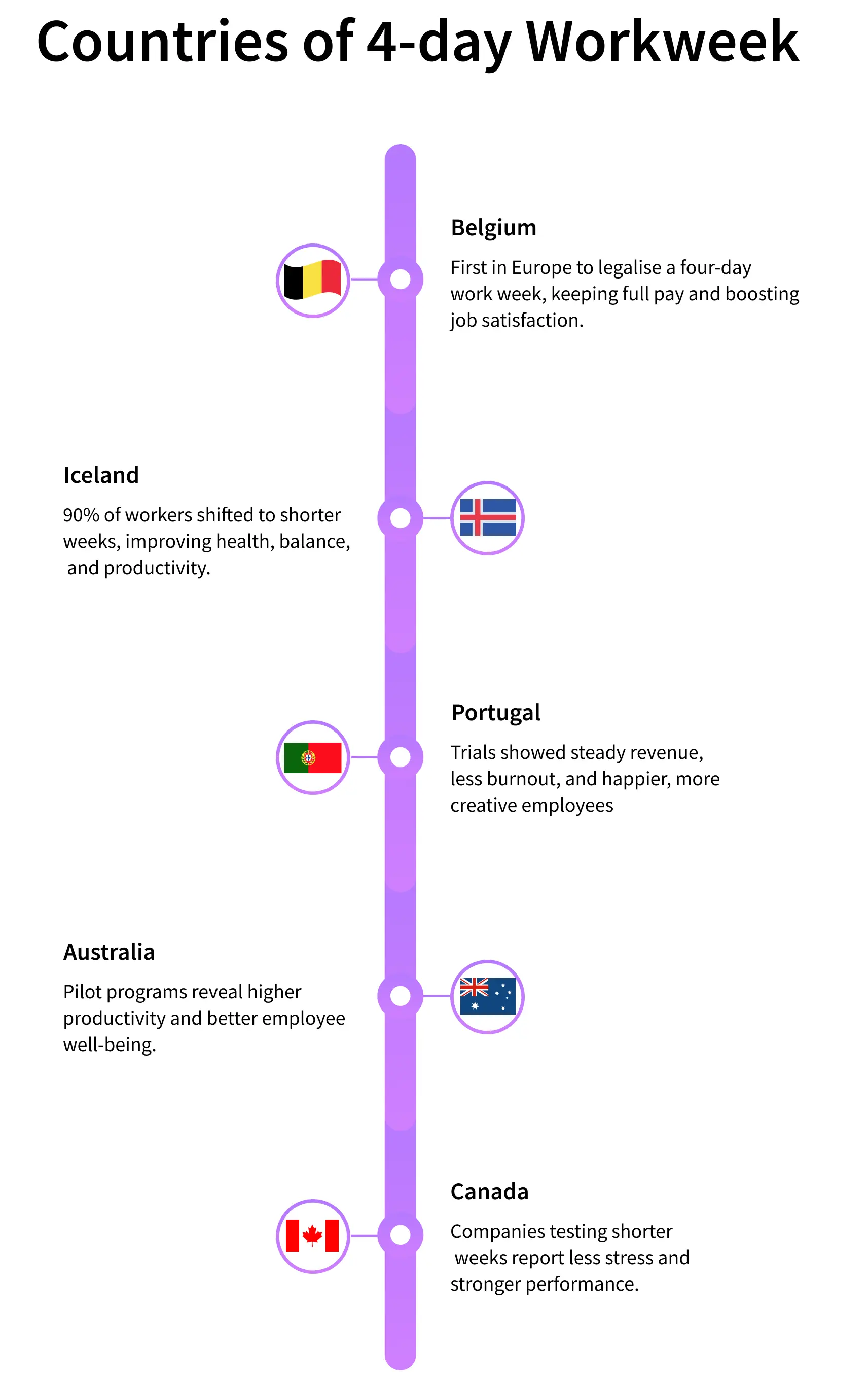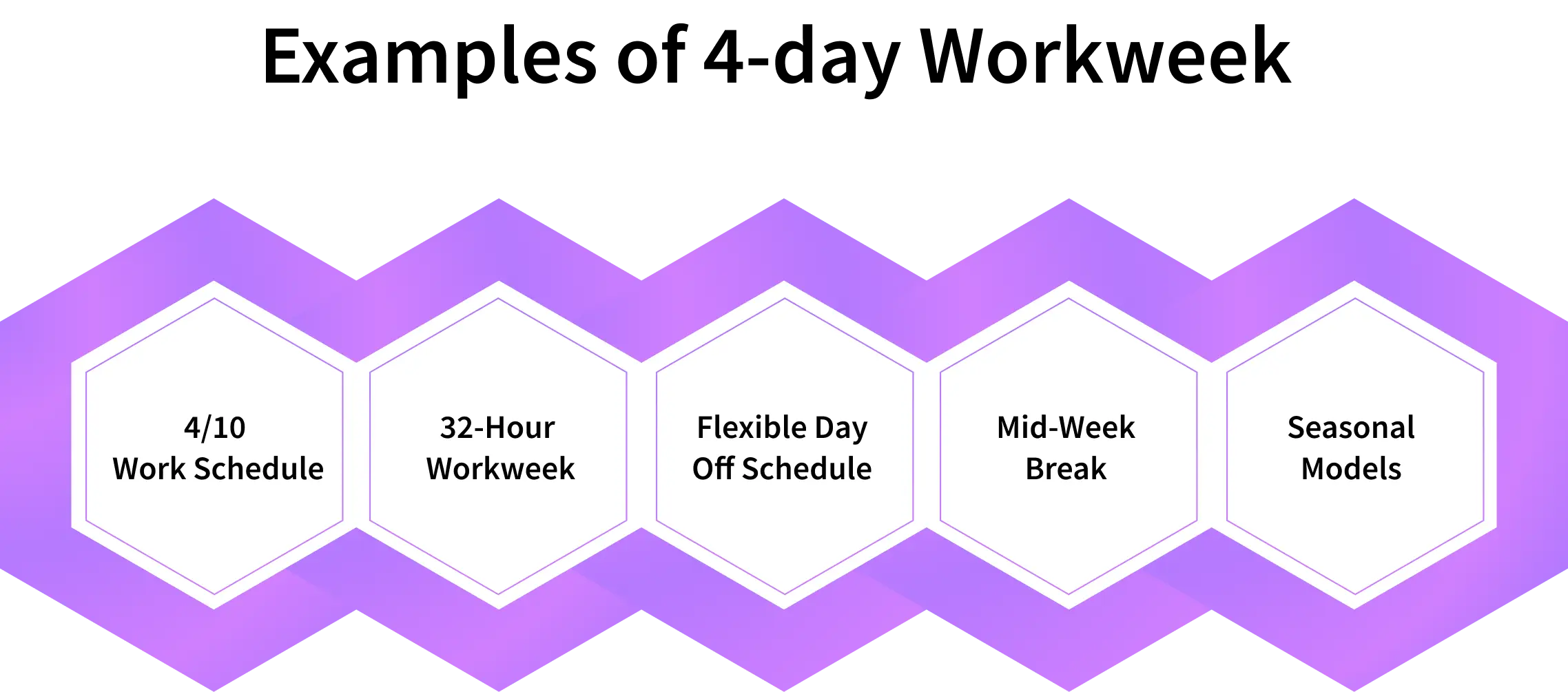The four-day workweek is transforming the modern workplace by enabling workers to have additional flexibility and time away from work, without loss of productivity or pay. Recent pilot programs in the United States and the United Kingdom, in Europe, and in Australia report improved employee well-being and improved organisational performance in industries ranging from health care to hospitality.
A four-day model may simply mean shorter hours each day, or a compressed workweek. Many firms that tried a four-day workweek have retained the model; nearly nine out of ten companies continued with the model after trials and studies were completed. One global study identified 2,800 employees from 141 companies had improved quality of life, and productivity as measured against normal workweek benchmarks has marked 2025 as "the year of the four-day workweek" in organisational life.
A four-day workweek is a way for full-time employees to complete their work in four days instead of five, sometimes without changes in pay and/or output. This type of workweek can include longer daily hours or simply the convenience of fewer hours in the week, whatever accommodates the employee and business. One of the main objectives of a four-day workweek is to provide work-life balance, minimise stress, and increase satisfaction among employees. There is flexibility in how organisations modify their working week successfully while allowing teams to feel more engaged in an autonomous way.
The increased support for flexibility, well-being, and enhanced performance has led to an increase in organisations transitioning to the 4-day workweek.
Global studies have shown that during a six-month trial period of the 4-day workweek, the prevalence of burnout and stress decreased, and employees were happier and healthier. Employees were able to utilise their additional time to rest and spend time with family/friends. Healthier employees are more resilient and valuable, leading to lower levels of absenteeism and turnover.
Organisations that implement a trial schedule continue to adopt the model after experiencing better retention of staff and strengthened recruitment efforts. Flexible scheduling allows organisations to retain top talent and provide appeal for Gen Z and millennials. Organisations establish a reputation of being progressive, attracting skilled professionals who value their time outside of work.
Several studies indicate that roughly 64% reported being less burned out and 38% reported lower stress levels, both of which contributed to higher levels of focus and energy while at work. Employees are less overwhelmed, which also means they will experience higher levels of satisfaction with their jobs and experience higher levels of performance metrics as a result. Additionally, when well-rested, employees communicate and collaborate better with one another as a team rather than experiencing burnout.
Some pilots in the UK indicated at least 8% improvement in the annual revenue, and productivity was rated at 7/10 by companies participating in the pilot. Increased efficiency creates an increment in output and project completion when doing work on a reduced number of days per week. Organisations that participated in the pilot project proved that shorter workweeks do not mean less work gets done.
Employees commute less, and time spent on environmentally friendly activities increased by 42% in trial groups . Fewer travel days result in less carbon emissions into the environment and savings on transportation. Companies with green beliefs will attract eco-conscious talent and customers.
Numerous countries are either implementing or testing the four-day work week, indicating a shift in the global world of work.

Belgium allows an employer to reduce their work week to four days, and they are the first to create such legislation in Europe. Employees receive the same pay, job security, and return to a three-day weekend every week. Companies in Belgium have reported employees being happier with their jobs and improved employee retention in the long term.
Over 90% of Iceland's workforce is now working an employee-side reduced hour week after many years of successful testing in Iceland. The national trial found that employees benefited from more time spent away from the workplace, and this was true in both public and private sector roles. Iceland was able to use its colleagues' experience to develop new influence across policy in the UK, Europe, Japan and New Zealand.
Portugal has gained useful inroads from countries that have tested the four-day work week. The test periods showed that companies had similar or improved revenue, burnout was lower and 65% of employees surveyed spent more time with family. The majority of employees surveyed during the trial said they enjoyed a four-day work week, and that they were more creative and happier when working shorter hours. Portugal's case proves the well-being and financial case for a 4-day work week.
Dozens and dozens of pilot companies and government programs are testing the four-day work week, or implementing it, while it is still new to apply in every context and requires a reasonable testing period. The efforts internationally reveal positive outcomes for productivity and employee health. The countries are naturally sharing the never-ending quest for the best outcomes, and best practices are transferred internationally.
The four-day workweek can take many forms, including a compressed arrangement for a standard 40-hour week. Another option is a total weekly hour reduction, with the hours per day remaining consistent. Additionally, flexible arrangements are available, offering set days off, rotating days off, or mid-weekdays off. Here are a few common 4-day workweek examples:

Description: 10-hour days for four days to accomplish a 40-hour work week as expected.
Example: Work Monday to Thursday, 8:00 a.m. to 7:00 p.m. with a one-hour lunch until Friday, Saturday, and Sunday.
Description: Reduced total hours in a workweek; typically, around 32 hours, through four days of work.
Example: Work four 8-hour days for a reduced work week of a 32-hour work week, producing a three-day weekend.
Description: Rather than a single fixed day off, various employees or teams will take different days off to spread operational coverage.
Example: Half the employees take Monday-Thursday shifts (for example), while the other half work Tuesday through Friday, or even different halves of the team take Wednesday off each week.
Description: Employees are given a day off in the middle of the week, a different type of break.
Example: Employees work a four-day work week, with a paid day off on Wednesday.
Description: Some companies utilise a 4-day workweek approach, then combine it as hybrid or remote/flex work options , or they only use it during certain times of the year.
Example: Some businesses, for instance, switch to a four-day workweek in the summer to raise morale and keep people from getting burned out. In the fall, they go back to a five-day workweek.
As organisations confronted with a pandemic crisis reassess the longstanding, habitual, and traditional five-day workweek, this moment is giving rise to the pursuit of shorter work hours and new schedules that will improve productivity and work-life balance. Two models gaining traction are the 4x10 model, in which employees work 10 hours a day for four days, and the 32-hour workweek, which reduces the week to four, eight-hour days, with no loss in pay. The fundamental tenets of both models are to challenge employees to work smarter and better, but not harder.
Various countries are piloting these concepts. The United Kingdom, the United States and New Zealand are a few countries that have experimented with a six-month, four-day workweek option. Most preliminary data from these studies suggest that with the appropriate time saved, employee job satisfaction increased, employee retention increased , and productivity remained more or less the same. The four-day workweek is more than just one extra day off, the logical goal of the four-day workweek is progression towards a more sustainable work-life balance, with a more supported work culture, with an emphasis on productivity.
Implementing a four-day workweek can be really good for an organisation, with some of the anticipated effects being improved employee wellness and productivity. However, putting in place a schedule like this does need careful, strategic thinking. See below for a step-by-step plan to facilitate your organisation's development of a four-day workweek.
Clarify your organisation's purpose for adopting a four-day workweek, attrition or improvement in productivity. And "why" for determining success metrics and organising everyone involved in the working group.
Assess which tasks can be eliminated, streamlined, or automated to sustain or enhance productivity. Ultimately, you need to achieve the conclusion of keeping the exact same quality and quantity of work without impacting service, but with less time spent.
Decide whether the model will be a compressed workweek or a reduced workweek model and plan a pilot for a duration of 3-6 months. The goal is to be able to assess a schedule, learn where things went wrong (or right), and we can correct it before implementing it 100%.
Communicate the pilot plan, the timeframe, and how the success metrics will be developed and reviewed (again, put it all in writing). Additionally, once the pilot is underway, ask for feedback on productivity and satisfaction from your staff.
The pilot will provide you with adequate data to make a decision regarding your staff's four-day workweek model. If you decide to adopt the 4-day workweek model, be prepared to adjust the model as you go (and, perhaps, for the duration of the time spent) for long-term success.
Organisations can figure out if the 4-day work week is right for their workers by weighing the pros and cons.
| Pros of 4-Day Workweek | Cons of the 4-Day Workweek |
|---|